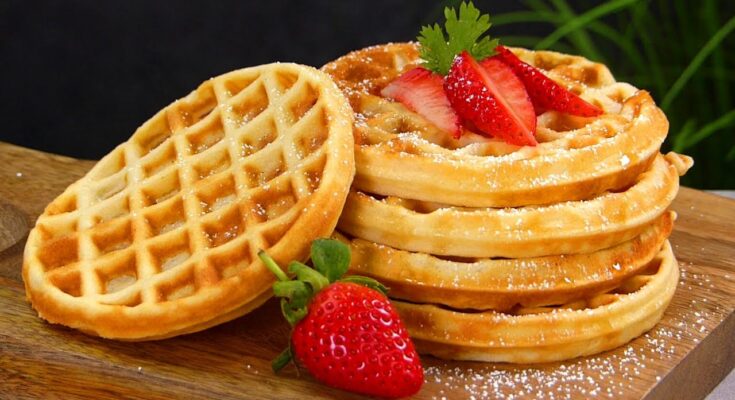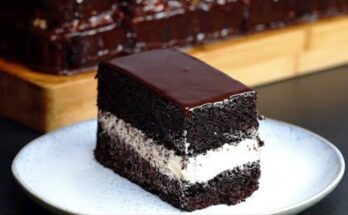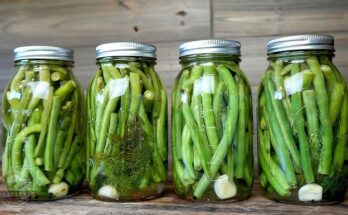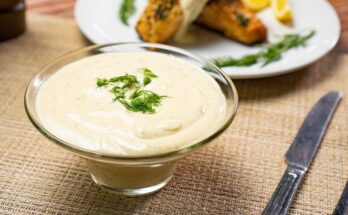Protein Waffle Recipe: Who doesn’t love waffles, right? But if you’re into fitness, trying to eat healthier, or just want to start your day with a protein-packed breakfast, traditional waffles might not make the cut. Enter: Protein Waffles—the delicious, muscle-friendly alternative to your classic breakfast favorite. This guide walks you through a simple, easy-to-follow process to make fluffy, golden waffles that are loaded with protein and taste just as good (if not better) than the original.
Protein waffles have surged in popularity over the last few years, especially among gym-goers, athletes, and health-conscious foodies. Why? Because they offer a guilt-free way to enjoy something indulgent while still sticking to your dietary goals. Whether you’re looking for a low-carb option, a post-workout meal, or just a healthy breakfast that keeps you full for hours, this protein waffle recipe has your back.
Let’s break down everything you need to know—from ingredients to equipment, step-by-step instructions, and bonus tips that’ll turn your kitchen into a waffle-making paradise. Ready to get started?
Introduction to Protein Waffles
Why Choose Protein Waffles?
Let’s face it: most breakfast foods are either overloaded with sugar or severely lacking in protein. That’s where protein waffles come in—they’re a perfect fusion of indulgence and nutrition. Think of them as the superhero of breakfasts: packed with protein to help build and repair muscles, and versatile enough to suit both sweet and savory cravings.
One big reason to choose protein waffles is satiety. Unlike sugary cereals or toast, protein keeps you full longer, reducing those mid-morning snack cravings. Plus, if you’re counting macros, they make it super easy to hit your protein goals without extra effort.
And here’s the best part—protein waffles don’t have to taste like chalk. With the right ingredients and flavor combinations, they’re every bit as satisfying as regular waffles, with the added benefit of being healthy.
Who Can Benefit from Protein Waffles?
You don’t have to be a bodybuilder to enjoy protein waffles. In fact, they’re great for:
- Busy Professionals: Quick to make and meal-prep friendly.
- Fitness Enthusiasts: Perfect for post-workout recovery.
- Kids and Teens: A healthier breakfast option that still feels like a treat.
- Vegans/Vegetarians: With plant-based protein options, everyone can get in on the fun.
Whether you’re trying to manage your weight, build muscle, or just eat a cleaner diet, protein waffles are a go-to solution. And the best part? You can make them right at home with ingredients you probably already have in your kitchen.
Ingredients You’ll Need
Protein Powder Options
Not all protein powders are created equal, especially when it comes to cooking. Some mix beautifully into batters, while others turn your food into rubbery messes. The best types of protein powders for waffles include:
- Whey Protein Isolate: Light texture, mixes well, neutral taste.
- Casein Protein: Thicker texture, makes waffles fluffier.
- Plant-Based Proteins (pea, rice, hemp): Great for vegan diets, slightly denser.
- Collagen Peptides: Adds a protein boost without affecting texture much.
When choosing a protein powder, look for one with minimal artificial sweeteners or fillers, and pick a flavor that complements your waffle style—vanilla and chocolate are classic choices.
Other Key Ingredients for Taste and Texture
Here’s a basic ingredient list that makes about 3–4 waffles:
- 1 scoop protein powder (about 25–30g)
- 1/2 cup oat flour or almond flour
- 1/2 tsp baking powder
- 1 egg (or flax egg for vegan)
- 1/2 banana (mashed) or 1 tbsp maple syrup for natural sweetness
- 1/2 cup almond milk or any milk of choice
- 1/2 tsp vanilla extract
- Pinch of cinnamon (optional)
- Cooking spray or a little coconut oil for greasing
You can customize this list depending on dietary needs—gluten-free, dairy-free, or even keto versions are totally doable. The combo of protein powder and flour gives structure, while egg and milk help bind and moisten. Banana or syrup adds a hint of sweetness without overloading on sugar.
Tools and Equipment Required
Waffle Maker Essentials
The cornerstone of your protein waffle recipe is a good-quality waffle maker. Whether you opt for a traditional Belgian waffle iron or a mini waffle maker, make sure it’s non-stick and easy to clean. Here are a few things to keep in mind:
- Adjustable Temperature Settings: Helps control browning and texture.
- Indicator Lights: Useful to avoid overcooking.
- Non-Stick Surface: Essential for easy removal and less mess.
If you don’t have a waffle maker, you can technically make these as pancakes, but you’ll miss out on that crispy exterior and iconic waffle pattern.
Mixing Tools and Kitchen Gadgets
You don’t need fancy gear, but having these on hand makes prep easier:
- Mixing Bowl: Preferably medium-sized with a wide rim.
- Whisk or Hand Mixer: Ensures a smooth, lump-free batter.
- Measuring Cups and Spoons: Accuracy is key to the right texture.
- Silicone Spatula: For scooping out every bit of batter.
Keeping things simple helps streamline the process, especially for early-morning cooks who don’t want to juggle a dozen tools.
Step-by-Step Guide to Making Protein Waffles
Step 1 – Prepare Your Ingredients
Start by gathering all your ingredients. Measure everything out ahead of time and set it on the counter. If you’re using bananas, mash them until smooth. Crack your egg into a separate bowl to avoid shell fragments.
Make sure your protein powder is not clumpy and that your baking powder isn’t expired—it’s the key to fluffy waffles.
Step 2 – Mix the Batter
This is where the magic starts. In a large mixing bowl, combine your dry ingredients first: protein powder, oat or almond flour, baking powder, and any spices like cinnamon. Give it a quick whisk to ensure everything’s evenly distributed—no one wants a surprise clump of baking powder in their waffle.
Next, stir in your wet ingredients: start with the mashed banana or maple syrup, then add the egg and milk. Mix thoroughly until a thick but pourable batter forms. If the mixture seems too dry, add a splash more milk; if it’s too runny, add a bit more flour. You’re looking for the consistency of traditional pancake batter—smooth and just thick enough to hold its shape when spooned into the waffle maker.
Let the batter rest for 2–3 minutes. This allows the baking powder to activate and results in fluffier waffles. It also gives the oat flour time to absorb the liquid, creating a more cohesive batter.
Pro tip: for added fluffiness, separate the egg yolk and white, beat the egg white until stiff peaks form, then fold it gently into the batter at the end. It’s a small step, but it makes a big difference in texture.
Step 3 – Preheat the Waffle Maker
While your batter is resting, it’s the perfect time to preheat your waffle iron. Most waffle makers take about 3–5 minutes to heat up. You’ll know it’s ready when the indicator light turns on, or when a drop of water sizzles instantly on the surface.
Spray the plates with a little non-stick cooking spray or brush lightly with coconut oil. This is crucial, especially with protein-based batters that can be a bit stickier than traditional ones.
Never pour the batter into a cold waffle maker—it won’t cook evenly and can become soggy. A properly preheated waffle iron ensures that you get those beautiful golden edges and that soft, fluffy interior every single time.
If you’re using a mini waffle maker, note that you’ll need less batter per batch—about ¼ cup should be enough. For Belgian or larger models, ½ to ¾ cup is usually perfect.
Step 4 – Cook Your Waffles
Now the fun begins—cooking! Once the waffle maker is hot and ready, pour in the batter and spread it evenly. Don’t overfill, as the batter will expand and can overflow, creating a mess.
Close the lid gently and let the waffle cook undisturbed for about 3–5 minutes. Resist the urge to peek! Opening the waffle maker too soon can tear the waffle and ruin the texture. Most models have an indicator light or beep when it’s done, but you can also go by the smell—once your kitchen smells like warm banana bread or vanilla cake, you’re close.
When it’s time, open the lid slowly. The waffle should lift easily. If it sticks, let it cook for another minute. Use a silicone spatula or tongs to carefully remove the waffle and transfer it to a wire rack. This prevents the waffle from getting soggy on the bottom.
Repeat the process with the remaining batter, re-greasing the waffle plates lightly between each batch to ensure smooth releases every time.
Step 5 – Serve and Customize
Here’s where you can get creative. Protein waffles are a blank canvas—go classic with maple syrup and a pat of butter, or dress them up with fresh berries, nut butter, Greek yogurt, or a dusting of powdered erythritol.
If you’re watching your sugar intake, opt for sugar-free syrup or a drizzle of melted dark chocolate. For a savory twist, top with avocado, a fried egg, and hot sauce.
You can also make a waffle sandwich by using two waffles as “bread” and stuffing them with turkey, spinach, and mustard—great for lunch or a protein-packed snack.
Store any leftovers in an airtight container in the fridge for up to 3 days, or freeze them for up to 2 months. Just pop them in the toaster to reheat—they’ll crisp up perfectly.
Tips for Perfect Protein Waffles
Avoiding Common Mistakes
Even though making protein waffles is pretty straightforward, there are a few common pitfalls that can lead to disappointing results. Here’s what to watch out for:
- Using the wrong protein powder – Not all powders cook the same. Some, especially cheaper ones, can turn your batter gritty or dry. Stick with a high-quality, baking-friendly protein powder.
- Too much powder, not enough moisture – It’s tempting to throw in extra scoops of protein, but doing so without balancing the wet ingredients can make your waffles dense and rubbery.
- Overmixing the batter – Like with pancakes, overmixing activates the gluten in the flour (if you’re using any wheat-based flour), which can make the waffles tough. Mix just until combined.
- Not preheating the waffle iron – This is one of the biggest mistakes. A cold waffle maker leads to uneven cooking and limp, soggy waffles. Always let it preheat fully.
- Skipping the rest time – Allowing the batter to sit for a few minutes before cooking helps the ingredients bind and leads to better texture.
By avoiding these common mistakes, you’re already well on your way to waffle perfection. And remember, your first waffle is often a test—use it to tweak the cooking time or batter amount if needed.
Flavor Variations to Try
Now that you’ve mastered the base recipe, let’s talk flavor. Protein waffles are insanely versatile. You can easily customize them based on what you’re craving or what’s in your pantry. Here are a few delicious variations to inspire your next batch:
- Chocolate Lover’s Waffles: Add 1 tbsp unsweetened cocoa powder and a few dark chocolate chips. Use chocolate-flavored protein powder for double the indulgence.
- Peanut Butter Banana: Mix 1 tbsp natural peanut butter into the batter. Top with sliced bananas and a drizzle of honey.
- Pumpkin Spice: Replace banana with pumpkin puree, add ½ tsp pumpkin spice, and top with Greek yogurt and a sprinkle of granola.
- Blueberry Burst: Fold fresh or frozen blueberries into the batter before cooking. Serve with lemon zest and a dollop of vanilla yogurt.
- Savory Herb Waffles: Omit sweeteners and vanilla, add chopped herbs, garlic powder, and a pinch of cheese. Top with avocado and poached eggs.
You can also get creative with your toppings. Greek yogurt, cottage cheese, almond butter, sliced fruits, or even a scoop of protein ice cream can transform a basic waffle into a show-stopping meal.
Nutritional Benefits of Protein Waffles
Macronutrient Breakdown
One of the key reasons people turn to protein waffles is the balanced nutrition they offer. A typical serving of protein waffles (about two medium-sized waffles) can pack in:
- 20–30 grams of protein
- 10–20 grams of carbohydrates (depending on the flour and sweeteners used)
- 5–10 grams of fat (especially if nut butters or whole eggs are used)
This macronutrient combo is ideal for breakfast or post-workout recovery. The high protein content aids in muscle repair, the carbs replenish energy, and the fats help with satiety and nutrient absorption. It’s a complete meal in waffle form.
Unlike traditional waffles that are mostly empty calories and refined carbs, protein waffles can help stabilize blood sugar, prevent energy crashes, and keep you full for longer. That’s a major win if you’re trying to maintain a healthy diet or manage your weight.
Customizing for Dietary Needs
The beauty of protein waffles is that they’re super adaptable to various diets:
- Low-Carb/Keto: Use almond flour or coconut flour and a low-carb protein powder. Skip the banana and use stevia or erythritol as a sweetener.
- Vegan: Use plant-based protein, a flax or chia egg substitute, and almond milk. Add a touch of coconut oil for richness.
- Gluten-Free: Stick to oat flour, almond flour, or gluten-free all-purpose blends.
- Dairy-Free: Choose plant-based milk and protein powders without whey or casein.
You can even tweak the recipe to be paleo or Whole30 compliant with the right substitutions. Just be mindful of the texture, as some alternative flours and proteins can change how the waffles cook.
Meal Prep and Storage Tips
How to Store Protein Waffles
If you’re a meal prepper (or just someone who values a quick breakfast), protein waffles are a game-changer. Here’s how to make the most of your waffle-making session:
- Fridge Storage: Store cooked waffles in an airtight container in the fridge for up to 3 days. Reheat in the toaster or air fryer for a crispy texture.
- Freezer Storage: Allow waffles to cool completely, then stack them with parchment paper between each one. Freeze in a zip-top bag or container for up to 2 months.
Reheating Made Easy
When you’re ready to eat, there are a few quick methods to bring your waffles back to life:
- Toaster: Best for crispiness. Just pop them in and toast until heated through.
- Air Fryer: 350°F for 3–5 minutes for a crispy finish.
- Microwave: Quick but softens the waffle—only use this method if you’re in a rush.
Reheating them correctly ensures you get that perfect combo of crispy outside and fluffy inside every time.
FAQs about Protein Waffle Recipe
1. Can I use pancake mix for protein waffles?
Yes, but for added protein, you’ll need to mix in a scoop of protein powder and maybe reduce the flour slightly to keep the right consistency.
2. Why are my protein waffles dry?
This usually happens if you use too much protein powder or not enough wet ingredients. Make sure your batter is thick but pourable.
3. Can I make protein waffles without eggs?
Absolutely. Use a flax or chia egg, or even mashed banana or applesauce as a binder in vegan versions.
4. Are protein waffles good for weight loss?
Yes, especially when they’re low in sugar and high in protein—they help you stay full longer and curb cravings.
5. What’s the best protein powder for waffles?
Whey isolate and casein are great for baking. For plant-based options, go for pea or rice protein for a good texture.
Conclusion
Protein waffles aren’t just another health fad—they’re a genuinely delicious, nutritious, and convenient way to upgrade your breakfast game. Whether you’re looking to increase your protein intake, find a new post-workout meal, or just want to indulge in something sweet without guilt, protein waffles tick all the boxes.
They’re easy to make, endlessly customizable, and can be adapted for almost any dietary preference. And with the right tools, ingredients, and a little creativity, you can turn your kitchen into a waffle wonderland that serves up tasty, protein-rich meals all week long.
So what are you waiting for? Whip up a batch of protein waffles and taste the healthy difference for yourself. Breakfast just got a major upgrade!



